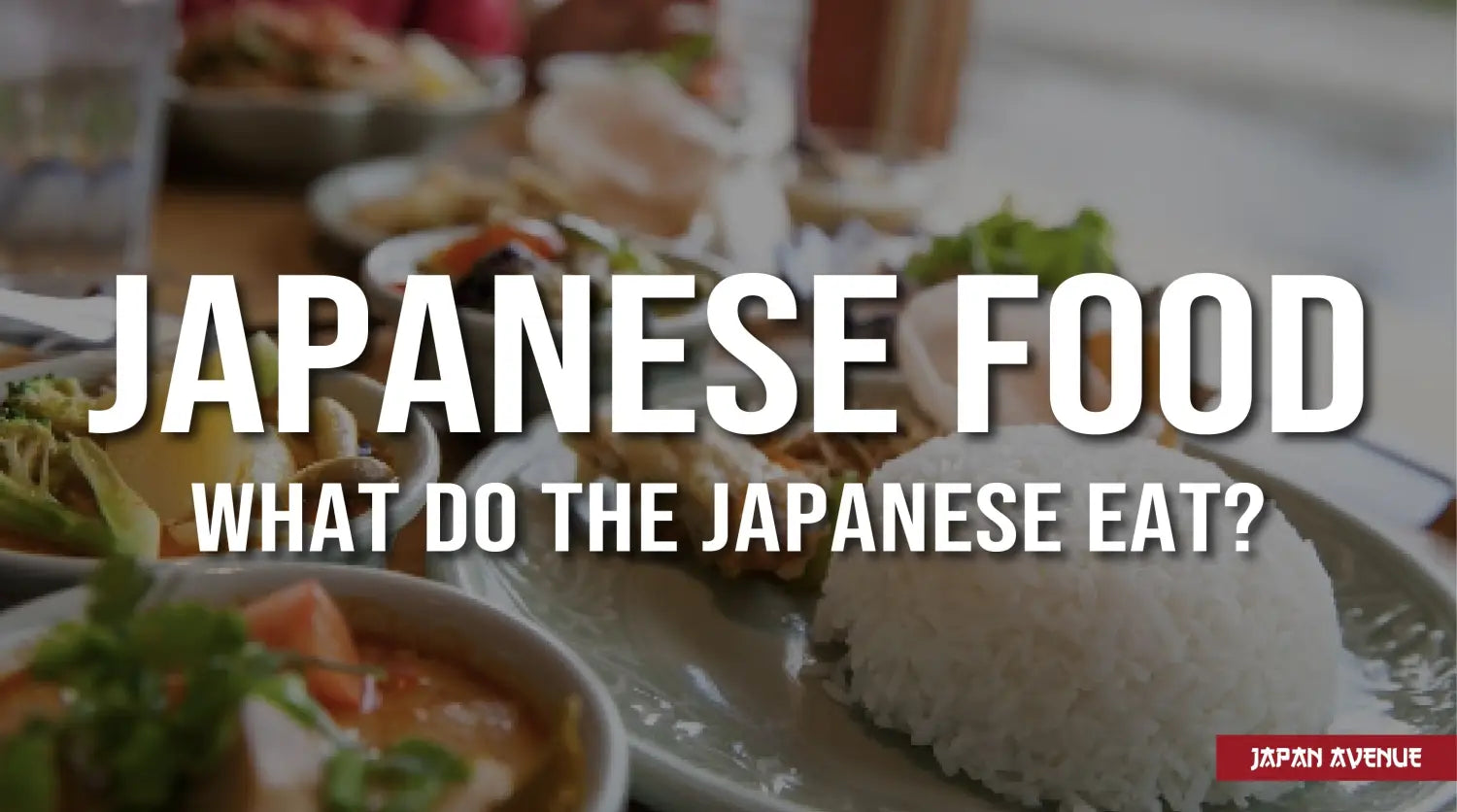Japanese cuisine influences the greatest chefs in the world. For good reason, Japanese gastronomy and its authentic flavors have everything to please!
However, the real Japanese cuisine is a little different from what we are used to taste. Indeed, it is not limited to the sushi and tempura that can be found in all Japanese restaurants.
So, what do Japanese people eat? Discover the main ingredients of this diet recognized as one of the healthiest in the world!
🥢 The basics of the Japanese diet

Japanese people use high quality and fresh products to cook. It is not without reason that their food is reputed to be beneficial to health. Among the must-try food of Japanese cuisine, we find rice which is the basis of the diet, seasonal vegetables, raw fish, seafood and soups.
🍚 Rice and its derivatives
Its name "gohan" refers to "meal". This cereal, rich in minerals and trace elements, is the basis of the traditional Japanese cuisine. The rice used in the archipelago is the "Japonica" variety recognizable by its round grain and sticky texture. Before cooking it, it is rinsed with cold water and then cooked with a rice cooker to ensure perfect cooking. Considered a sacred food, rice has many powers in Japanese mythology and is subject to many traditions.
🍝 Ramen and other Japanese noodles

An alternative to rice: ramen, soba and udon. These are varieties of noodles that are extremely popular in Japan. Ramen are always served in a broth; udon are large white noodles that are eaten cold or hot and soba are buckwheat noodles served with sauce. Note that each region has its own specialties.
🥦 Vegetables of the archipelago
The Japanese particularly appreciate root vegetables and squash such as white radish called "daikon", Japanese onions called "negi", carrots called "ninjin", sweet potatoes called "satsuma-imo" or even pumpkin called "kabocha". Green leafy vegetables are also widely used in traditional cooking. Thus, many varieties of cabbage can be found: hakusai (Chinese cabbage), kyabetsu (cabbage)... spinach "horenso", or even mizuma salad which looks like our arugula. Lastly, shitake mushrooms accompany many Japanese dishes.
In Japan, vegetables are often steamed, wok-fried, simmered or even fermented in order to preserve vitamins and nutritional qualities. They are served as a side dish to the main course, in soups, in salads and they can even be found in sweet preparations such as red azuki beans. On the other hand, fruits are not much consumed in Japan, as most of them are imported... and therefore very expensive. However some fruits produced on the archipelago will have more reasonable prices like persimmon, nashi pear, Fuji apple, yuzu (kind of lemon), peaches, cherries and mandarins.
🦑 Fish in the archipelago

It is well known that Japanese people eat a lot of fish and more rarely meat (chicken, pork and beef...). Fish and seafood, most often eaten raw, grilled or fried, are some of the common foods in Japanese cuisine. Among the favorite species are salmon, tuna, sanma (a knife-shaped fish), sea bream or eels. Similarly, the Japanese are fond of seafood: shrimp, sea urchins and octopus are among many Japanese culinary specialties.
🌱 Japanese condiments
Traditional Japanese cuisine is characterized by its condiments and herbs that give unique iodized flavors called "umami".
Japanese broths and herbs
Dashi is a very common ingredient in traditional Japanese cuisine. It is a broth made of dried bonito, konbu or mushrooms that is used for miso soup and many other Japanese dishes. Lastly, seaweed, spring onion, shiso, ginger, wasabi and other aromatic plants are used to flavour dishes.
Soy
Soybeans are used in all their forms: soy sauce in ramen, fermented soybean paste in miso soup, tofu, beans, sprouts...
Rice spirits and vinegars

Sake and mirin are frequently used for flavoring dishes. Similarly, rice vinegar is used to season salads or sauces.
🍴 What do Japanese people eat on a daily basis?
Japanese eating habits are very different from ours. Actually, there is no notion of appetizers, main courses or desserts since all the dishes are served at the same time. In general, the Japanese diet is rich in fibers, minerals and vitamins and low in fats and fast sugars which is why it is much more balanced than the Western diet. Moreover, nutritionists highly recommend this way of eating!
🍳 What do Japanese people eat for breakfast?

While people over here have adopted the sweet breakfast based on bread, cereals, fruits or even pastries, in the archipelago people eat savory dishes in the morning. Thus, we start the day with a bowl of white rice served alone, with seaweed, an egg or even natto (fermented soybeans) for the bravest. Similarly, miso soup full of good nutrients is a must. The first meal of the day is always accompanied by proteins in the form of Japanese omelette (tamagoyaki), grilled salmon or tofu. Pickled vegetables called Tsukemono are also part of the most important meal of the day to provide fiber, minerals and vitamins. These include cucumbers, white radishes or fermented plums preserved in a sauce. Lastly, matcha tea, rich in antioxidants, is the traditional drink served at breakfast. However, Japanese people are also big consumers of coffee.
As for the young Japanese, they prefer the western fashion with buttered toast with jam and fruit juice to which they sometimes add an omelet.
🍱 What do the Japanese eat for lunch?

Lunch is often taken on the run during the lunch break. Workers, school kids and students usually bring a box with pre-cooked food. This is the famous bento box traditionally prepared (with love) by the mother or the wife. Once again, the dish is composed of rice, vegetables and pieces of fish (or meat). Sometimes, salarymen in a hurry eat ramen but the star of the Japanese lunch is without any doubt the onigiri, a triangle of rice filled with fish and surrounded by a sheet of nori seaweed. What to drink? Tea of course!
🥤 What do the Japanese eat at snack time?

Dorayaki, Japanese pancakes
Like Westerners, Japanese kids, like grown-ups often snack in the afternoon. These can be sweet dishes (cakes, seasonal pastries...) or salty ones (skewers) accompanied by a hot or cold drink.
🍲 What do Japanese people eat in the evening?

Dinner is the most traditional meal of the day. In the evening, Japanese people mainly eat rice served with miso soup and three side dishes. Fish, vegetables, meat... Let's make way for delicious Japanese dishes (donburi, gyoza, nabe, tempura, ...)! In addition, more and more families opt for street food so as to savor noodles, brochettes and other local specialties. Finally, in the Land of the Rising Sun, it is not uncommon to eat outside in izakaya (small Japanese restaurants). Tea and pastries can also be served in case you feel hungry before going to bed. Note that cakes are very little sweetened in Japan.
It is not for nothing that the inhabitants of the archipelago have such a long life expectancy. When we look in detail at what the Japanese eat, we realize that their diet is rather well balanced! And you, will you switch to Japanese cuisine?



